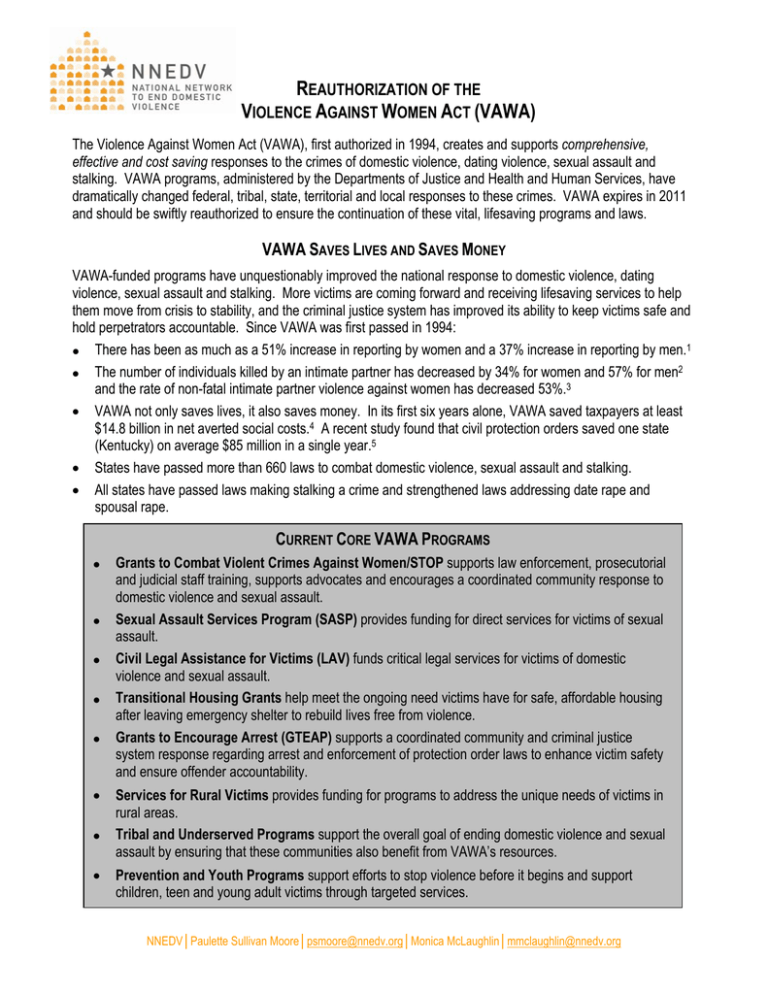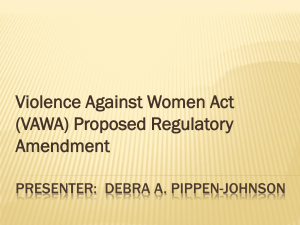
REAUTHORIZATION OF THE
VIOLENCE AGAINST WOMEN ACT (VAWA)
The Violence Against Women Act (VAWA), first authorized in 1994, creates and supports comprehensive,
effective and cost saving responses to the crimes of domestic violence, dating violence, sexual assault and
stalking. VAWA programs, administered by the Departments of Justice and Health and Human Services, have
dramatically changed federal, tribal, state, territorial and local responses to these crimes. VAWA expires in 2011
and should be swiftly reauthorized to ensure the continuation of these vital, lifesaving programs and laws.
VAWA SAVES LIVES AND SAVES MONEY
VAWA-funded programs have unquestionably improved the national response to domestic violence, dating
violence, sexual assault and stalking. More victims are coming forward and receiving lifesaving services to help
them move from crisis to stability, and the criminal justice system has improved its ability to keep victims safe and
hold perpetrators accountable. Since VAWA was first passed in 1994:
There has been as much as a 51% increase in reporting by women and a 37% increase in reporting by men.1
The number of individuals killed by an intimate partner has decreased by 34% for women and 57% for men2
and the rate of non-fatal intimate partner violence against women has decreased 53%.3
VAWA not only saves lives, it also saves money. In its first six years alone, VAWA saved taxpayers at least
$14.8 billion in net averted social costs.4 A recent study found that civil protection orders saved one state
(Kentucky) on average $85 million in a single year.5
States have passed more than 660 laws to combat domestic violence, sexual assault and stalking.
All states have passed laws making stalking a crime and strengthened laws addressing date rape and
spousal rape.
CURRENT CORE VAWA PROGRAMS
Grants to Combat Violent Crimes Against Women/STOP supports law enforcement, prosecutorial
and judicial staff training, supports advocates and encourages a coordinated community response to
domestic violence and sexual assault.
Sexual Assault Services Program (SASP) provides funding for direct services for victims of sexual
assault.
Civil Legal Assistance for Victims (LAV) funds critical legal services for victims of domestic
violence and sexual assault.
Transitional Housing Grants help meet the ongoing need victims have for safe, affordable housing
after leaving emergency shelter to rebuild lives free from violence.
Grants to Encourage Arrest (GTEAP) supports a coordinated community and criminal justice
system response regarding arrest and enforcement of protection order laws to enhance victim safety
and ensure offender accountability.
Services for Rural Victims provides funding for programs to address the unique needs of victims in
rural areas.
Tribal and Underserved Programs support the overall goal of ending domestic violence and sexual
assault by ensuring that these communities also benefit from VAWA’s resources.
Prevention and Youth Programs support efforts to stop violence before it begins and support
children, teen and young adult victims through targeted services.
NNEDV│Paulette Sullivan Moore│psmoore@nnedv.org│Monica McLaughlin│mmclaughlin@nnedv.org
VAWA REAUTHORIZATION
While VAWA programs have greatly enhanced systemic changes to meet the needs of victims and have saved
countless lives, more work still needs to be done. VAWA’s reauthorization should build upon its successes and
continue progress towards breaking the cycle and culture of violence.
Reauthorization of VAWA should enhance:
Our national efforts to save lives and save money;
Successes of current programs to meet the full range of victims’ needs;
Judicial, law enforcement and medical systems’ abilities to provide effective interventions;
Housing, workplace and military protections for victims;
Youth services working in collaboration with schools, college campuses and other local community
organizations to protect victims;
Services for tribal victims;
Accountability for offenders; and
Prevention programs to break the cycle of violence.
We urge Congress to swiftly reauthorize VAWA to ensure a continued federal response to domestic
violence and sexual assault.
“Intimate Partner Violence in the U.S.” U.S. Department of Justice, Office of Justice Programs, Bureau of Justice Statistics. Jan 2008.;
Archer, C., et al Institute for Law and Justice, National Evaluation of the Grants to Encourage Arrest Policies Programs 14 (Nov. 2002).
2 Uniform Crime Report (UCR) Supplementary Homicide Reports (SHR), Federal Bureau of Investigation. (Decrease is based on data
collected between 1993 and 2007).
3 National Crime Victimization Survey (NCVS). U.S. Department of Justice, Office of Justice Programs, Bureau of Justice Statistics.
(Decrease is based on data collection between 1993 and 2008).
4 Anderson Clark, K., et al (2002). “A Cost-Benefit Analysis of the Violence Against Women Act of 1994.” Violence Against Women, 8,
417.
5 Logan, T. K., Walker, R., Hoyt, W., & Faragher, T. (2009 September). p.146 The Kentucky Civil Protection Order Study: A Rural and
Urban Multiple Perspective Study of Protective Order Violation Consequences, Responses, & Costs. Lexington, KY: University of
Kentucky.
1
NNEDV│Paulette Sullivan Moore│psmoore@nnedv.org│Monica McLaughlin│mmclaughlin@nnedv.org

